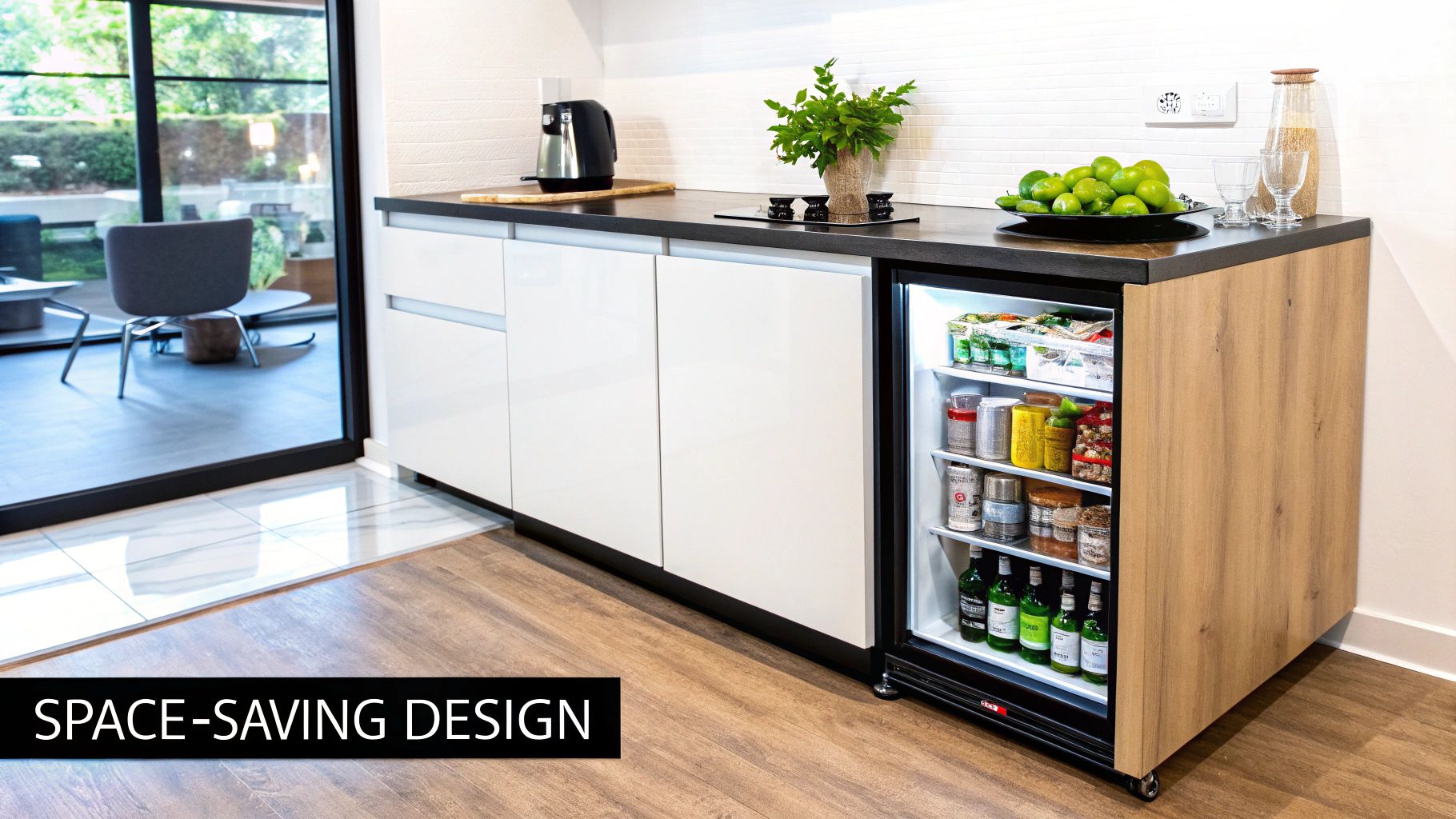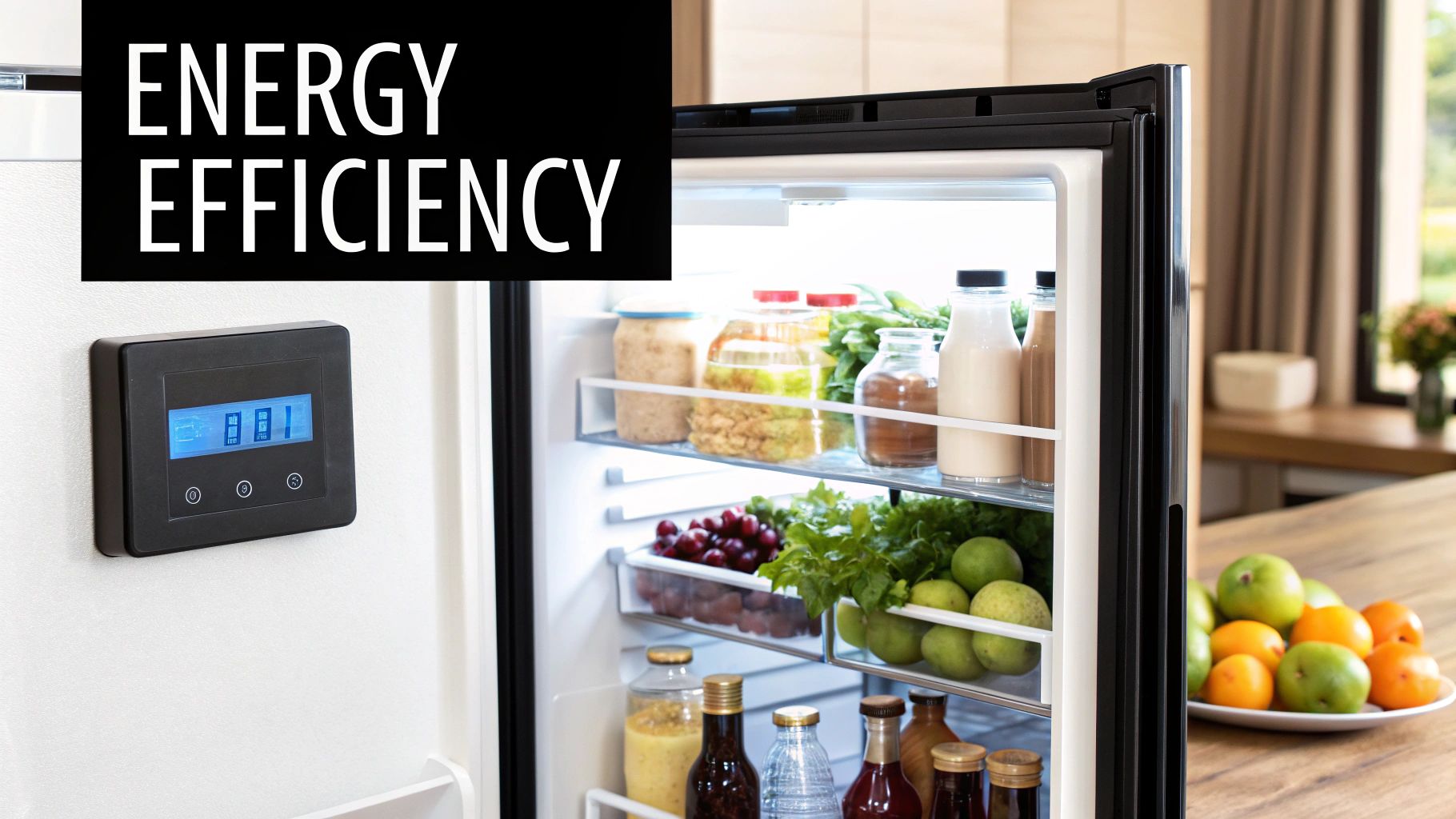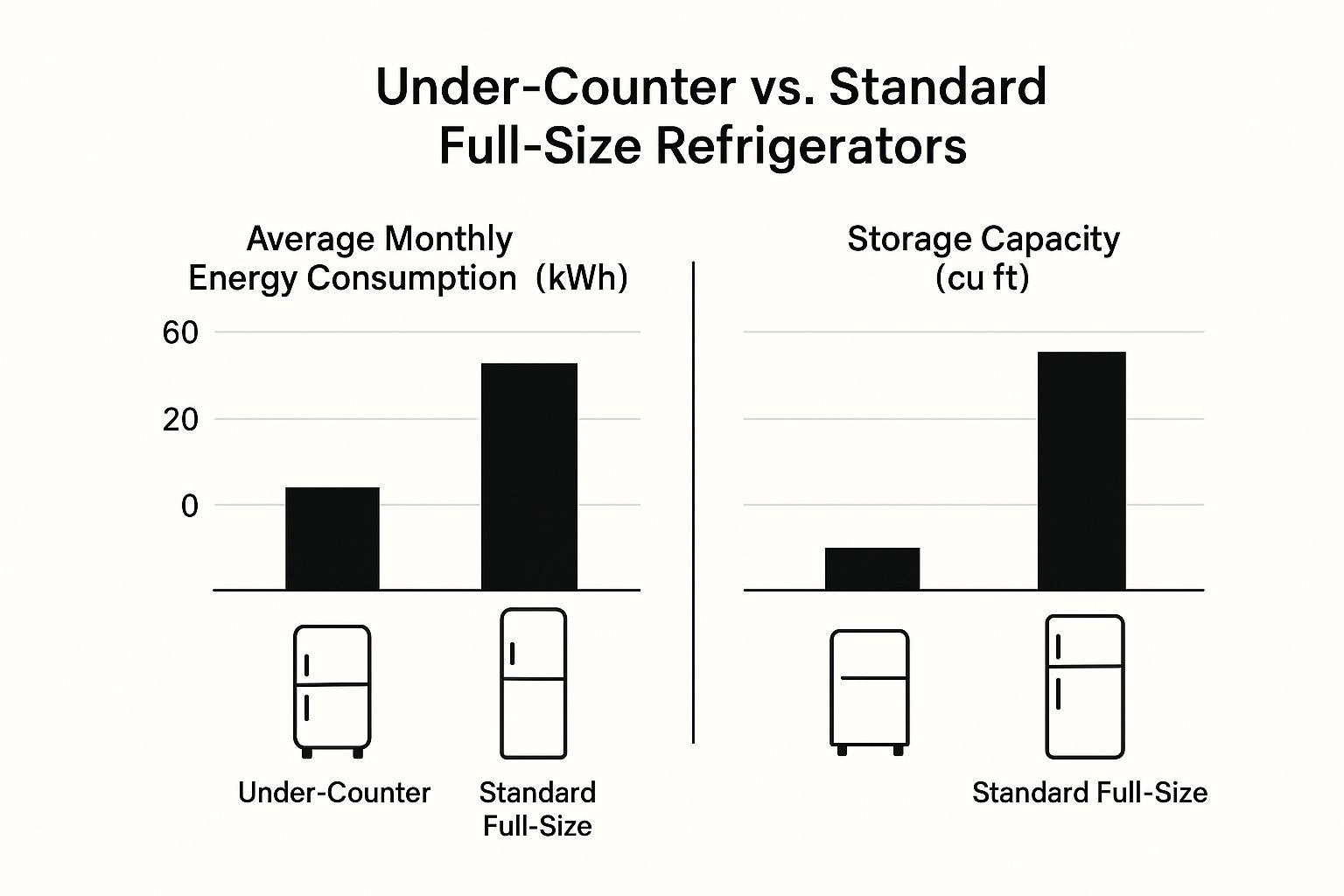
Choosing Your Under Counter Refrigerator
Share
An under counter refrigerator is a slick appliance made to tuck right under your countertops. It's the perfect way to get some extra chill space for drinks and food without taking up a lot of room. Think of it as the ultimate blend of convenience and modern design, making it a fantastic addition to kitchens, home bars, or entertainment spaces.
Why Under Counter Refrigerators Are So Popular
Don't just think of an under counter refrigerator as a mini-fridge. It's much smarter than that. This is a strategic piece of equipment designed to solve modern problems with space and convenience. These compact units are champions of efficiency, turning otherwise forgotten spots into functional, easy-to-reach cooling zones. The result is a seamless, built-in look that declutters your kitchen and makes the whole space flow better.

Their popularity really comes down to how versatile they are. Pop one into a kitchen island, and suddenly your fresh produce and ingredients are right where you need them for meal prep. No more running back and forth to the main fridge. In a home bar or media room, it becomes the go-to beverage center, keeping drinks perfectly chilled and ready for guests without them having to trek through your main kitchen. It just makes entertaining and daily life that much easier.
A Growing Trend in Modern Homes
The demand for these appliances isn't just some passing fad; it's part of a bigger shift in how we design our homes. As more of us fall in love with open-concept living and create amazing outdoor kitchens, the need for refrigeration outside of one central unit has exploded.
In fact, the market for undercounter refrigerators was valued at USD 1.75 billion and is expected to hit USD 2.85 billion. That steady growth is tied directly to the rise of smaller living spaces and the boom in dedicated home entertainment areas. You can explore more data on this market growth to see the key drivers for yourself.
An under counter refrigerator is a smart investment in your home’s functionality and style. It offers a sophisticated solution that adds value by improving organization, maximizing space, and elevating the overall user experience in any room.
To sum it up, this is about more than just getting extra cold storage. Choosing an under counter refrigerator is a deliberate design decision that improves your lifestyle. It doesn't matter if you're a serious cook, a frequent entertainer, or just someone who loves an organized, efficient home. By understanding what they bring to the table, you can pick the perfect model for your needs and create a more functional, stylish living space.
Let’s quickly break down the key advantages.
Under Counter Refrigerator Benefits at a Glance
This table sums up why adding an under counter refrigerator can be such a game-changer for your home.
| Benefit | How It Helps You | Best For |
|---|---|---|
| Space Optimization | Fits perfectly under counters, freeing up valuable floor space. | Small kitchens, apartments, or anyone looking to maximize their layout. |
| Enhanced Convenience | Keeps drinks, snacks, or ingredients exactly where you need them. | Home bars, media rooms, outdoor kitchens, and busy food prep areas. |
| Improved Workflow | Reduces trips to the main refrigerator during cooking or entertaining. | Avid home cooks, frequent entertainers, and families with kids. |
| Aesthetic Appeal | Creates a sleek, integrated, and high-end look in any room. | Modern kitchen designs, home renovations, and custom-built bars. |
| Specialized Cooling | Models like wine coolers or beverage centers offer precise temperature control. | Wine enthusiasts, craft beer lovers, and anyone needing dedicated storage. |
As you can see, the benefits go far beyond simple refrigeration, offering a tailored solution that fits both your space and your lifestyle.
Finding the Right Type for Your Needs
Picking an undercounter refrigerator isn't a one-size-fits-all decision. It's more like choosing the right tool for a specific job. You wouldn't use a hammer to turn a screw, and you definitely shouldn't grab a generic model when a specialized one will serve you so much better. The reality is, not all units are created equal; each type is designed with a particular purpose in mind, from chilling drinks for a big party to carefully preserving a prized wine collection.

Think of this section as your personal shopper. We're going to walk through the most popular models out there, breaking down the key differences. This will help you match the perfect appliance to your lifestyle, whether you're a frequent entertainer, a passionate cook, or just looking to add a touch of convenience to your day.
Beverage Centers: The Social Hub
A beverage center is basically the ultimate drink station. These units are specifically engineered to keep a wide variety of drinks—soda, beer, sparkling water—at that perfect, ice-cold serving temperature, usually somewhere around 34-40°F. With adjustable shelves and almost always a clear glass door, they put your entire drink selection on display, making it a breeze for guests to grab what they want.
This design is a natural fit for home bars, media rooms, or even a covered outdoor patio. By setting up a dedicated beverage zone, you keep guest traffic out of the main kitchen work triangle, which is a massive win during busy gatherings.
Wine Coolers: The Personal Cellar
Now, a wine cooler (or wine refrigerator) is a much more specialized appliance. Its main job is to protect your wine collection by maintaining a perfectly consistent temperature and humidity, creating the ideal environment for aging and storage. A beverage center keeps things frigid, but a wine cooler operates in a warmer range, typically between 45-65°F.
You'll also find that many models offer dual-zone cooling. This is a fantastic feature that lets you store reds and whites at their respective ideal temperatures, all in the same unit. For any wine enthusiast looking to preserve the flavor and integrity of their bottles, a wine cooler is an essential buy.
An undercounter refrigerator is more than just a place to keep things cold; it's a specialized component of your home's design. The right model not only adds function but also elevates the experience of the room it's in.
General Storage: Solid Door vs. Glass Door
For everyday overflow storage, a standard undercounter refrigerator is incredibly versatile. When you go this route, you'll typically be choosing between two main door styles:
- Solid-Door Models: These are your best bet for insulation and energy efficiency. They look just like a miniature version of a traditional refrigerator and are perfect for stashing snacks, produce, or other perishable items out of sight.
- Glass-Door Models: These give you a sleek, high-end look and let you see what's inside at a glance. They might be a little less energy-efficient because of the glass, but they are fantastic for showcasing a curated collection of craft beers or colorful drinks.
Drawer Refrigerators: Effortless Organization
Finally, we have drawer refrigerators, which offer a unique and seriously convenient alternative. Instead of a single swinging door, these units feature pull-out drawers that make it incredibly easy to access items, especially things that would normally get lost in the back.
That top-down view is a complete game-changer for organization, preventing forgotten leftovers from disappearing into the abyss. They integrate beautifully into kitchen islands and are particularly user-friendly for households with kids or for anyone with mobility challenges. Thinking through these different types is the key to ensuring your new appliance fits your life perfectly.
Decoding Features and Custom Options
Once you've nailed down the type of undercounter refrigerator you need, the real fun begins. The details are what take an appliance from good to great, and it's time to dig into the specific features that will make it a perfect fit for your daily life. Think of this as your personal checklist to make sure the unit you pick not only fits the space but works exactly how you need it to.

These features are the custom tools that tailor the appliance to your home. A wine lover, for example, is going to be looking for a completely different set of options than a parent stocking up on juice boxes and after-school snacks. Let's break down the features that make the biggest impact.
Temperature and Storage Flexibility
One of the most valuable features you’ll find is dual-zone cooling. This tech is a game-changer, creating two completely independent temperature zones inside the same unit. It's an absolute must if you want to store different types of drinks properly. You can chill sodas and beers down to a frosty 38°F in one section while keeping your red wines at a cellar-perfect 55°F in another.
Beyond just temperature, take a close look at the interior layout. Adjustable shelving offers incredible flexibility, letting you reconfigure the space on the fly to fit tall bottles, bulky Tupperware, or party platters. Some models even have shelves that slide out or fold up, helping you use every last inch of space.
A great under counter refrigerator adapts to your needs. Features like dual-zone cooling and flexible shelving aren't just minor upgrades; they are core components that define the appliance's utility and convenience in your home.
Practical Features for Everyday Use
Sometimes, the simplest features are the ones you end up appreciating the most. Here are a few things that can make a huge difference in day-to-day use:
- Reversible Door Hinges: This sounds simple, but it’s a lifesaver. It lets you change which way the door swings open, making the unit adaptable to tricky kitchen layouts or tight corners.
- ADA-Compliant Height: Models that are ADA-compliant are built for accessibility. Their controls are easy to reach and they fit comfortably under 34-inch countertops, which is a key part of universal design.
- Door Alarms: A door alarm is a simple alert that goes off if the door is left ajar. It’s a small thing that saves energy and prevents your food from spoiling.
Smart Technology and Certifications
Tech is making these appliances smarter and more efficient than ever. In fact, the global market for household undercounter refrigerators is expected to hit roughly $2.5 billion, driven largely by smart features and energy savings. Many new units come with precise digital temperature controls, so you can set and monitor temps with pinpoint accuracy. Some even connect to mobile apps for remote control.
On another note, if your unit will be used in a commercial-style kitchen or serious food prep area, certifications really matter. For instance, understanding what NSF certification is can help you pick a model that meets strict health and safety codes. Details like this ensure the refrigerator you choose isn't just convenient, but also safe and reliable for the long haul.
Under Counter Units in Commercial Kitchens
In a fast-paced professional kitchen, every second and every square inch is prime real estate. Efficiency isn't just a nice-to-have; it's the engine that drives the whole operation. This is where the commercial under counter refrigerator proves its worth, becoming the backbone of any productive prep station. It’s not just an appliance—it's an integrated part of your workflow.
These aren't your typical home refrigerators. Commercial workhorses are built tough, usually tucked inside rugged stainless steel prep tables. This smart combination gives you a durable, hygienic workspace on top with critical cold storage right below. Ingredients are literally at your fingertips, which means no more wasted steps running back and forth to a walk-in.
Standard Refrigerated Prep Tables
The most common setup you'll see is the standard stainless steel prep table with a built-in refrigerated base. Think of it as the ultimate kitchen multitasker. The top gives you a generous, easy-to-clean surface for all your chopping, mixing, and plating. Meanwhile, the refrigerated section below keeps bulk items like produce, meats, and sauces at a perfectly safe and consistent temperature.
You’ll find this kind of table in almost any commercial kitchen, from a fine dining restaurant to a high-volume catering business. It’s a masterclass in efficiency, combining two vital functions—prep space and cold storage—into one compact footprint. That kind of smart design is exactly what you need to keep things running smoothly, especially when the dinner rush hits.
Specialized Sandwich Prep Tables
Getting more specialized, we have units designed for very specific jobs. A sandwich prep table is a fantastic example. These tables take that standard refrigerated base and add a game-changing feature: a refrigerated rail across the top, perfectly fitted to hold multiple food pans.
This rail is your organized, chilled command center for toppings—lettuce, tomatoes, onions, cheese, you name it. It lets a line cook build sandwiches and salads with lightning speed, grabbing fresh, cold ingredients without ever opening the main refrigerator door. For any deli, café, or sandwich shop, this setup is absolutely essential for keeping up with orders while maintaining quality.
In a commercial setting, integrated refrigeration isn't a luxury; it's a core component of operational excellence. The right prep table can dramatically reduce ticket times, improve food safety, and maximize the productivity of your kitchen staff.
High-Function Pizza Prep Tables
Along the same lines, a pizza prep table is another piece of highly specialized gear. It’s built with an extra-deep work surface to handle large pizza doughs and a wide, refrigerated rail designed to hold an army of toppings. Pepperoni, mushrooms, different cheeses, and sauces are all kept chilled and within arm's reach.
This design lets a pizza maker work in a straight, efficient line—stretching the dough, saucing it, and adding toppings without ever taking a step away from their station. This level of integration is a must-have for any pizzeria trying to pump out a high volume of orders quickly and consistently. By combining a durable stainless steel work surface with optimized refrigerated storage, these tables are true game-changers in any kitchen focused on specific menu items.
A Practical Guide to Installation
So you've picked out the perfect undercounter refrigerator. Now comes the final, crucial step: proper installation. Getting this right is about more than just finding an outlet and plugging it in. It's the key to making sure your new appliance runs efficiently and lasts for years.
The first thing you need to understand is the critical difference between a freestanding and a built-in model. This is where a lot of people go wrong.
Think of it like this: a freestanding unit is like a table lamp. It needs open air all around it to dissipate heat and cool down. A built-in unit, on the other hand, is like recessed lighting—it's engineered from the ground up to live inside a structure. It does this with a special front-facing ventilation system, allowing it to "breathe" properly even when it's snugly tucked into your cabinetry. Trying to cram a freestanding unit into a tight cabinet space is a recipe for disaster. It'll overheat, work itself to death, and fail way sooner than it should.
Before you get to the exciting part of sliding your new fridge into place, let's run through a few quick checks. Taking a few minutes to cover the basics now will save you a world of headaches later on.
Key Installation Steps
- Check Your Electrical: Make sure you have a dedicated, properly grounded outlet within reach of the cord. Nearly all of these units run on a standard 115/120V, 60Hz circuit. Whatever you do, don't use an extension cord. They can be a serious fire hazard and might not deliver the steady power your fridge's compressor needs.
- Plan for Plumbing: If your model comes with an ice maker or a water dispenser, you'll need a water line nearby. This usually means running a small copper or braided steel line from your home's cold water supply to the back of the unit.
- Get it Level: This might seem like a small detail, but it's not. A refrigerator that isn't level can cause the door to seal improperly, which leads to condensation, temperature swings, and wasted energy. Grab a level and adjust the unit's feet until it's perfectly stable.
Don't mistake placement and leveling for minor tweaks—they have a direct impact on your refrigerator's energy bill and its overall lifespan. A door that doesn't seal right forces the compressor to work overtime, burning through electricity and wearing out components much faster.
The whole point of an undercounter model is efficiency and convenience. This infographic really drives home how much less energy they use compared to their full-size cousins.

As you can see, you get a ton of convenient, compact storage without the hefty energy footprint. By taking the time to install your appliance correctly, you ensure it runs as efficiently as the day it was made, giving you reliable cooling right where you need it most.
Simple Maintenance for Lasting Performance
Protecting your investment in an undercounter refrigerator is a lot easier than you might think. A consistent, simple maintenance routine is all it takes to keep your unit humming along efficiently for years to come.
Think of it less like a major overhaul and more like a quick, regular check-up. Just a few simple habits can sidestep common problems, extend the appliance's life, and save you from a lot of headaches down the road.
Your Essential Maintenance Checklist
Regular upkeep doesn't have to be some complicated affair. Just sticking to a basic checklist will keep your unit in prime condition, making sure it cools effectively and operates quietly.
Here are the core tasks you'll want to focus on:
- Clean the Interior: Every month or two, give the inside shelves and walls a good wipe-down with a mix of mild detergent and water. This is the simplest way to stop odors before they start and keep your storage space hygienic. For the outside, knowing how to properly clean stainless steel will keep it looking brand new.
- Clear the Condenser Coils: The condenser coils are like the unit's lungs; they push out heat to keep the inside cold. When they get caked in dust and grime, the refrigerator has to work way harder to do its job. Give them a quick cleaning with a brush or vacuum every six months to keep energy efficiency at its peak.
- Check Gaskets and Seals: Take a close look at the door gaskets for any signs of cracking or brittleness. A tight seal is absolutely critical for keeping that cold air locked in. If the seal is weak, the unit will run constantly trying to catch up, which is a big drain on power.
Regular maintenance isn’t just about being clean; it’s about being smart with your money. A well-maintained undercounter refrigerator can use 10-25% less energy than one that's been neglected, a difference you’ll definitely see on your utility bills.
Troubleshooting Common Issues
Even with the best care, you might run into a hiccup now and then. Don't panic.
Hearing some strange noises? It often means the unit isn't perfectly level, causing the compressor to vibrate. If your unit just isn't cooling like it used to, the first and easiest thing to check is a dusty condenser coil.
By following these simple tips, you can ensure your undercounter refrigerator remains a reliable workhorse in your kitchen for the long haul.
Frequently Asked Questions
As you get closer to choosing the perfect undercounter unit, a few last-minute questions might pop up. This section is all about giving you clear, simple answers to the most common things we get asked, so you can feel totally confident in your decision.
Can I Install a Regular Mini Fridge Under My Counter?
No, and trying to do so is a really bad idea. A standard mini fridge is a freestanding unit, which means it needs plenty of open space around its back and sides to vent heat properly.
If you box one into your cabinetry, you’re basically suffocating it. It will overheat, run around the clock trying to stay cool, and burn out in no time. A true undercounter refrigerator, on the other hand, is specifically designed as a "built-in" appliance with a front-facing ventilation system, allowing it to breathe perfectly when installed flush with your cabinets.
How Noisy Are Under Counter Refrigerators?
The noise level can really vary from one model to the next, but the good news is that most premium units are built to be whisper-quiet. Many operate somewhere between 30-40 decibels (dBA), which is about as loud as a quiet library.
If you’re planning to put your refrigerator in a main living space, like a home bar or media room, keep an eye out for models marketed as "silent" or just double-check the manufacturer's decibel rating.
The key difference between a wine cooler and a beverage center is specialization. A wine cooler is a personal cellar for aging, while a beverage center is a versatile station for serving ice-cold drinks.
What Is the Real Difference Between a Wine Cooler and a Beverage Center?
The easiest way to think about it is that a wine cooler is a specialist, while a beverage center is a generalist. A wine cooler’s entire purpose is to store wine at the ideal temperature for aging, which is usually in the 45-65°F range.
A beverage center, however, is all about getting drinks like soda, beer, and water down to frosty serving temperatures, typically hovering around 34-40°F. While some high-end dual-zone models can handle both, knowing their main job will help you pick the right one for your home.
Find the perfect under counter refrigerator or commercial prep table to upgrade your space at PrepTables.com. Explore our extensive collection of high-quality, durable equipment today at https://preptables.com.
